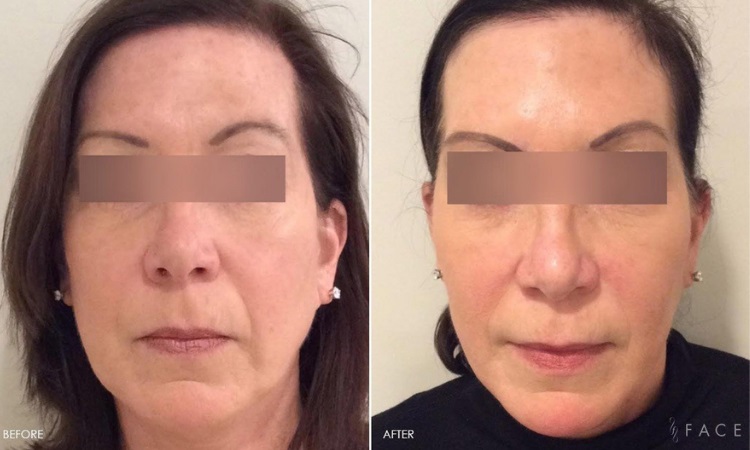How Long Does a Liquid Facelift Last?
The components of a liquid facelift last for different periods. Hyaluronic acid dermal fillers last between six and twelve months, but more new innovations have them lasting an average of one year to a year and a half.
Botox® and similar products last three to four months. You can schedule maintenance treatments to keep your results looking refreshed and youthful. Since appointments for injectables like dermal fillers and Botox® only take a few minutes, you can fit an appointment into even the busiest schedule to keep yourself looking smooth and rejuvenated.
Risks and Side Effects
A liquid facelift carries some risks, though they are generally minimal. Common side effects include bruising, swelling, and redness at the injection sites. These usually resolve within a few days.
In rare cases, more serious complications can occur. These include infections, lumps, or allergic reactions. There’s also a risk of unintended effects like asymmetry or overcorrection. Proper placement of fillers is crucial to avoid these issues.
Choosing a skilled, board-certified injector reduces these risks. Always discuss your medical history and any allergies before the procedure. Being informed helps you make safer decisions.
Before and After Care Instructions
Proper care before and after a liquid facelift is crucial for optimal results. Before the procedure, avoid alcohol and blood-thinning medications like aspirin for at least a week. This helps reduce the risk of bruising.
After the procedure, apply ice packs to the treated areas to minimize swelling. Avoid strenuous activities and heavy exercise for 24-48 hours. Refrain from touching or massaging the injection sites to prevent filler movement.
Keep your head elevated while resting, especially in the first 24 hours. Staying hydrated and following your injector’s specific instructions will support a smooth recovery. Most patients return to normal activities within a day or two.
What Results to Expect From a Liquid Facelift
You can expect to see an immediate increase in volume after injecting dermal fillers. Common areas for these fillers during a liquid facelift include the cheeks, lips, and under the eyes. Dermal fillers also lift and soften the appearance of fine lines and wrinkles. Botox® will relax and smooth away lines and wrinkles that form from repeated muscle movements, such as frown and smile lines. In the hands of a nurse injector, you will achieve a natural-looking lift and a healthy, youthful, re-energized appearance.
Expected Results and Timeline
Results from a liquid facelift are visible almost immediately. After dermal filler injections, you’ll notice increased volume and smoother skin. Common areas treated include the cheeks, lips, and under-eye regions.
Botox results, which target muscle-related wrinkles, may take a few days to become fully apparent. These injections smooth out frown lines, crow’s feet, and forehead wrinkles by relaxing the underlying muscles.
The full effects of a liquid facelift typically peak within two weeks. Over time, the fillers gradually break down, and you may notice a subtle decrease in volume. Maintenance treatments every 6-18 months are recommended to sustain your results.
Is There Any Downtime With a Liquid Facelift?
For the most part, you will not have downtime after a liquid facelift. You may have some minor soreness or swelling that can last a day or two, or bruising that will resolve within a week or two. You can return to regular activities right away.
Good Candidates For a Liquid Facelift
If facial volume loss has combined with lines and wrinkles to make you look older than you feel, you may be a good candidate for a liquid facelift. Both dermal fillers and Botox® are safe and minimally invasive.
Patient Testimonials and Case Studies
Hearing from others who have undergone a liquid facelift can provide valuable insights. Many patients report feeling more confident and satisfied with their appearance. They often highlight the natural look and minimal downtime as key benefits.
Case studies show that patients typically see immediate improvement in facial volume and a reduction in fine lines. For instance, one patient in her 40s noted a significant lift in her cheeks and smoother skin under her eyes, with results lasting over a year.
Before-and-after photos from these case studies provide a clear visual of what to expect. These real-world examples help set realistic expectations and show the potential outcomes of the procedure.
Comparison with Traditional Facelift
A traditional facelift is a surgical procedure. It tightens the skin and repositions underlying tissues. Results can last 10-15 years. However, recovery can take weeks. There are also higher risks, including scarring and infection.
On the other hand, a liquid facelift uses injections like Botox and dermal fillers. It’s non-surgical, providing immediate results. Recovery is minimal, often just a day or two. The effects, however, last only 6-18 months.
Traditional facelifts are ideal for more pronounced signs of aging. Liquid facelifts are better for those who want a quicker, less invasive option. The choice depends on how much change you want and your tolerance for recovery time and risk.








